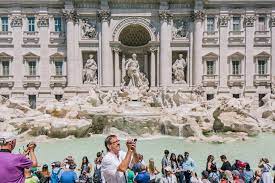Italy: Tourists throw over €1 million into Trevi Fountain each year

Rebecca Ann Hughes
Rome: Built between 1732 and 1762, the Trevi Fountain is one of Rome’s most iconic sights. It was designed by Nicola Salvi and represents the taming of the waters.
Against a monumental facade of giant Corinthian pilasters, river god Oceanus rides a shell chariot pulled by sea horses.
One of the creatures is docile while the other rears wildly, representing the contrasting characters of the sea.
As per tradition, tourists stand with their backs facing the monument and toss a coin over their left shoulder with their right hand into the water.

The ritual was made famous by the 1954 film “Three Coins in the Fountain” and is supposed to guarantee the visitor’s return to the Eternal City.
Each day, around €3,000 of loose change ends up in the Trevi Fountain. That works out as up to €1.5 million tossed into its waters each year.
The workers use brushes on the end of long poles to sweep the coins into piles and then use a suction hose to extract the money from the water. The coins are then bagged under the watchful eye of the police.
In 2001, the mayor decided that the money should be collected for a local charity to put a stop to the frequent attempts by people to steal coins from the fountain.

Since then, the loose change that ends up in the fountain has been donated each year to Rome’s Catholic charity Caritas.
It has been a huge boost for the charity and the sum now makes up 15 per cent of its annual budget.
The group uses the money to help the city’s poor and needy. It funds soup kitchens, homeless shelters, free supermarkets and other projects.
It also goes towards the upkeep of a complex on the outskirts of Rome housing a nursing home, canteen and dentist for city residents living in poverty.





